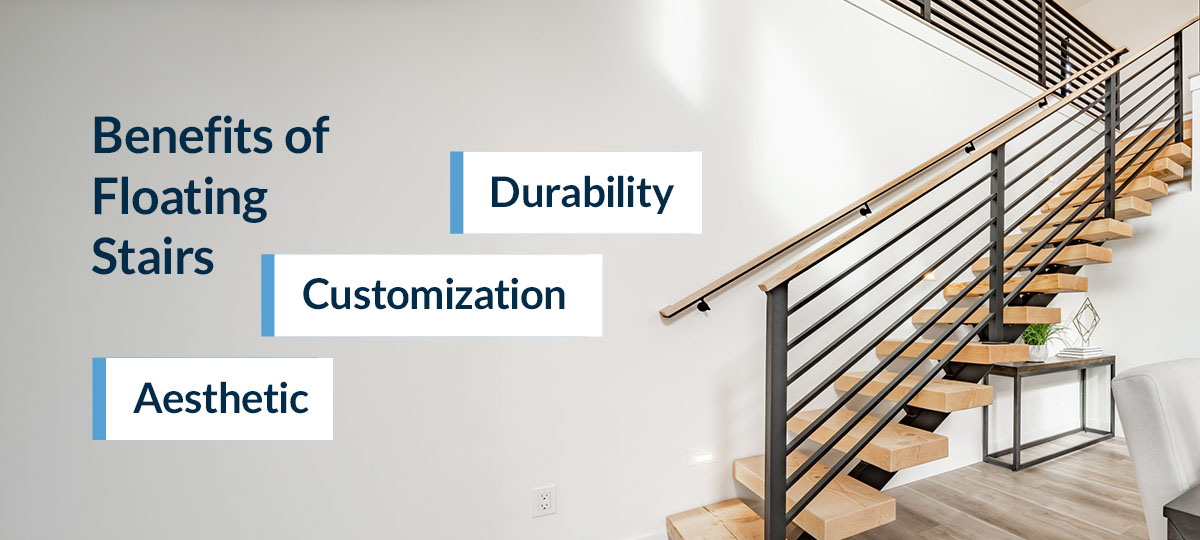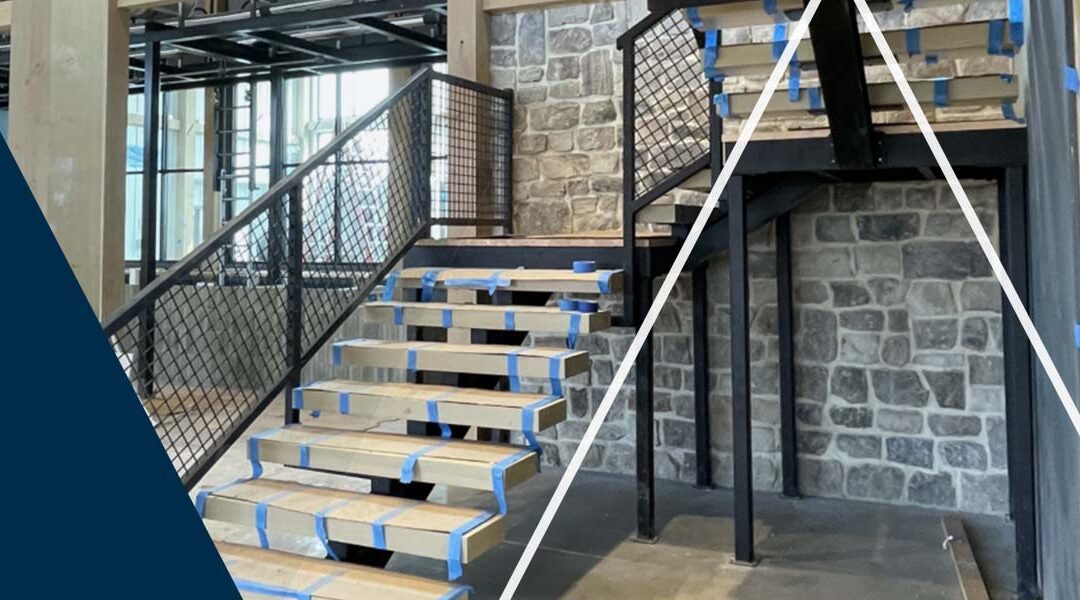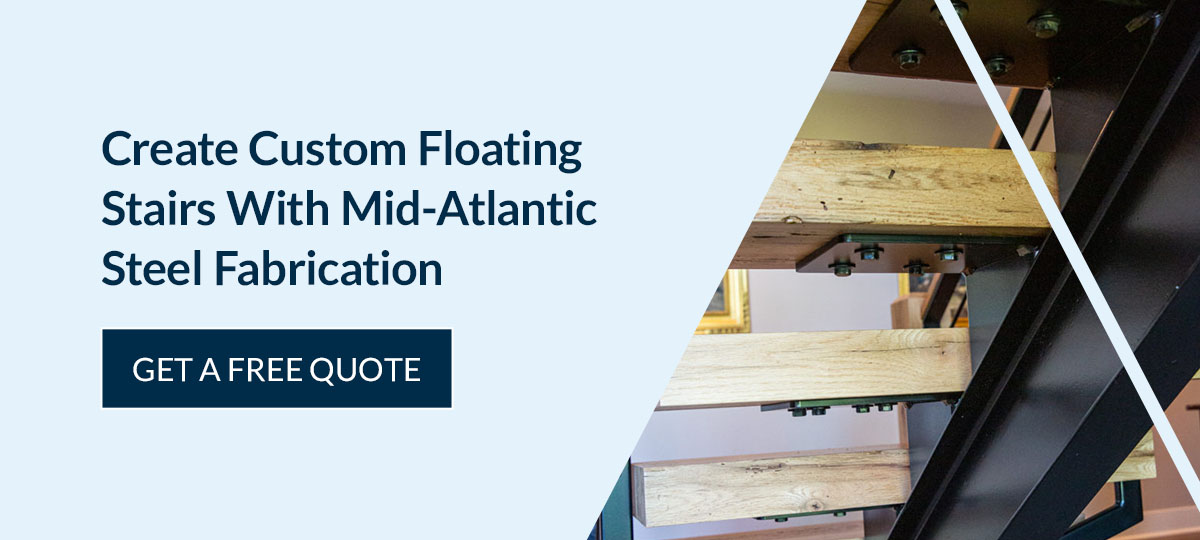If you’re looking for a stable, high-quality staircase with a modern aesthetic, a floating staircase may be the perfect solution for your project. This kind of staircase is easily customizable and will fit within many different spaces and design constraints. Floating staircases are typically built with modern materials like steel, glass, and wood.
Although floating staircases look challenging to construct, they’re built with the same principles as traditional staircases. However, the supporting structures are hidden, making it look like the stair treads are suspended in the air. Because of their bold design, floating staircases are often used in high-scale buildings with a modern, updated aesthetic.
Learn more about floating staircases, how they work, and the different types to consider.
What Are Floating Stairs?
A floating staircase gives the illusion that each stair is floating in midair. It achieves this effect with hidden support structures, glass, and missing risers. You can see through this kind of stairs, and the empty spaces and increased natural light add to their effect. Floating stairs are sometimes also called cantilevered or suspended stairs.
The more glass you incorporate into a floating staircase, the more it will look like an impossible, exciting structure. For example, glass handrails keep the staircase visible while meeting safety codes. Some designers may even use clear treads, although not every guest or customer will feel comfortable being able to see down that far — you should always consider your audience while making stair design decisions.
Benefits of Floating Stairs
As a style and construction choice, floating stairs offer several benefits to a finished space:

- Durability: Floating staircases are typically built with a metal support structure. Steel and other quality metals last a long time, resist damage, and can support weight safely without degrading. If you’re concerned about the durability of stairs in your construction design, floating stairs are a good choice.
- Customization: This kind of staircase comes in many different configurations, so you can fit it seamlessly into your design. When you install a floating staircase, you can have it built to the precise specifications for your construction project. Even the metal support can be fabricated to a specific size and shape, offering a high level of customization.
- Aesthetic: Because of their unique design elements, floating staircases bring a modern, upscale feel to buildings. They’re an excellent choice for buildings like hotels, restaurants, and private residences.
If you choose to install floating stairs, you can achieve a timeless look that will remain stable and durable for many years. Because they’re made with fabricated metal parts, it’s easy to create and source a custom design for floating stairs.
How Do Floating Stairs Work?
Floating stairs use a hidden support structure to create the illusion that they’re hanging in the air. They also don’t have risers on the stairs so that you can see between the treads, heightening the sense of floating. Here are the parts of a floating staircase and how they work:
- Stringer: Stringers are the steel support structure that holds treads in place. While some floating staircases use a single stringer, others use a double stringer. These can be located on one side, both sides, or underneath the middle of a floating staircase. Some floating stairs use wall pockets for treads instead of a stringer.
- Treads: Treads are the part of a staircase that people step on. Common materials for treads include wood, glass, and metal. Sometimes, carpet is run down the stairs and tacked into place — however, this is less common for floating staircases since it blocks the empty riser spaces.
- Supports: Tread brackets are bolted to the stringer to support the treads, and an anchoring system attaches the stringer to the wall and floor. Floating staircases also use tread cores that provide structural support underneath each individual stair tread.
- Railing: Building codes require a railing for staircases with a certain number of steps. Many floating staircases use glass railings to help with the illusion of the suspended stairs. Another popular choice is using an industrial pipe to span the space between treads and the ceiling above.
- Landings: These are larger treads where the staircase turns a corner. Landings give people more space to navigate a sharp turn. They also break up staircases so people don’t feel like they’re climbing a mountain with no end in sight.
Traditional staircases also use risers, which are the part of a stair you can kick as you step up each tread. Risers are vertical and fit between treads. You won’t find risers in floating staircases — instead, these areas are empty and allow people to see through the stairs. Missing risers are what create the illusion of floating as people walk up the stairs and when the stairs are viewed from a distance.
Are Floating Stairs Safe?
Yes, floating stairs are safe when they’re built according to all requirements and building codes. Although floating stairs look like they don’t have support, they are extremely well-supported by steel stringers and other connecting supports. These supports are often covered by wall material, giving the illusion that the staircase is simply sitting along the wall.
Building codes include requirements for tread spacing, riser spacing, and the weight each tread can carry safely. Experienced steel fabricators operate within these codes to create staircases that meet all safety and legal requirements. The right spacing depends on code requirements and the width and height of the space where you’re installing a staircase.
How Much Does a Floating Staircase Cost?
Costs for a floating staircase vary depending on many factors, like size, shape, and materials. High-quality materials may cost more initially, but they’ll last longer and be easier to maintain. For safety reasons, it’s essential to work with an experienced fabricator for the metal support pieces and a trustworthy contractor who will install floating staircases properly.
Floating staircases are often more expensive than traditional staircases, but their aesthetic appeal is worth the cost to many businesses. Some floating staircase designs are less expensive than others — in general, staircases with hidden stringers and complex designs are more costly to install than basic staircase designs with visible stringer support.
Create Custom Floating Stairs With Mid-Atlantic Steel Fabrication
At MA Steel Fab, we’re a one-stop shop for laser, forming, and welding services. Our fabricators are D1.1 Structural-certified and have experience creating custom projects like floating staircases. We pride ourselves on clear communication, personal service, and the highest quality of product.
We’re committed to making your vision a reality while following all building codes for safety requirements. When you work with us, we’ll assign you an individual project manager to streamline product design and delivery. Our project turnaround time is typically six to eight weeks, so you can receive your custom order quickly and keep moving with construction.
Request a quote online today or call us at 717-687-7313 to learn how we can help with your project.

